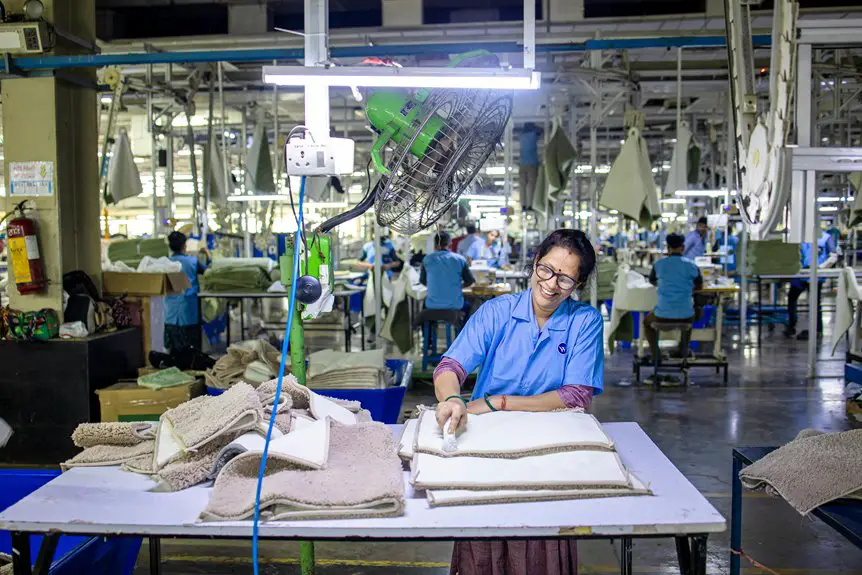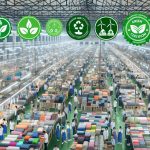You might not realize that Oeko-Tex® Standard 100 is one of the most recognized textile certifications worldwide. It guarantees that products are tested for harmful substances, promoting safety for consumers. However, while it offers significant benefits, it doesn’t promise complete sustainability. What does this mean for your choices in textiles, and how does it impact the industry as a whole? Let’s explore the intricacies of this certification and its implications.
Table of Contents
Key Takeaways
- Oeko-Tex® Standard 100 certifies textiles are free from harmful substances, ensuring safety for human health and the environment.
- The certification process requires detailed documentation and laboratory testing, which can be resource-intensive and costly for smaller manufacturers.
- While it promotes responsible sourcing and eco-friendly practices, it does not cover all sustainability issues, such as water consumption and energy efficiency.
- Consumers should be aware of the certification’s limitations and research beyond labels to fully understand sustainability claims.
- Certification can enhance market appeal and attract eco-conscious consumers, but does not guarantee complete sustainability.
Understanding Oeko-Tex® Standard 100 Certification
What does it mean when a textile is Oeko-Tex® Standard 100 certified?
When you see this certification, it signifies that the fabric has been rigorously tested for harmful substances. This means that the textile is free from toxic chemicals and meets strict safety standards for human health.
You’re not just buying a product; you’re investing in assurance that it’s safe for you and your loved ones. This certification applies to every component of the textile, from fibers to dyes, ensuring that nothing harmful is present.
Oeko-Tex® aims to promote transparency in the textile industry, helping you make informed choices. Knowing that a product is Oeko-Tex® certified can give you peace of mind while shopping for clothing and home textiles.
The Certification Process Explained
When you’re ready to pursue Oeko-Tex® Standard 100 certification, understanding the application requirements is your first step.
Next, you’ll navigate the audit and compliance process to guarantee your products meet the necessary standards.
Finally, it’s important to be aware of the renewal process and the challenges that may arise along the way.
Application Requirements Overview
Maneuvering the Oeko-Tex® Standard 100 certification process involves several key application requirements that you’ll need to meet. First, you’ll have to guarantee your products have been tested for harmful substances. Next, you must provide detailed documentation about your materials and production processes. Finally, you’ll need to submit samples for laboratory testing.
Here’s a quick overview of these requirements:
| Requirement | Description | Purpose |
|---|---|---|
| Product Testing | Verify absence of harmful substances | Ensure consumer safety |
| Documentation Submission | Provide material and process details | Maintain transparency |
| Sample Submission | Send product samples for lab testing | Confirm compliance |
Audit and Compliance Steps
As you navigate the Oeko-Tex® Standard 100 certification process, understanding the audit and compliance steps is vital for ensuring that your products meet the necessary standards.
First, you’ll need to gather documentation and samples of your textiles for testing. A recognized testing institute will then evaluate your products for harmful substances, following rigorous guidelines.
After testing, an audit of your production processes will occur, evaluating compliance with Oeko-Tex® requirements. This includes reviewing your manufacturing practices, supply chain transparency, and environmental impact.
If your products pass, you’ll receive certification, but it’s essential to maintain compliance through regular evaluations. By staying proactive in these steps, you can assure your customers of your commitment to safety and sustainability.
Renewal Process and Challenges
Although you’ve successfully obtained Oeko-Tex® Standard 100 certification, the renewal process can present several challenges that require careful attention.
You’ll need to conduct regular audits to confirm ongoing compliance with the stringent criteria. This means keeping track of any changes in materials or manufacturing processes that could affect your certification status.
Additionally, you might face increased scrutiny as standards evolve, necessitating continuous education on new regulations.
Documentation is vital; make sure all records are up-to-date and readily accessible for review.
It’s also essential to maintain clear communication with your suppliers to assure they meet the required standards.
Finally, budget for possible costs associated with the renewal process, including testing and administrative fees, to avoid any unexpected hurdles.
Benefits of Oeko-Tex® Standard 100 for Businesses
Oeko-Tex® Standard 100 offers multiple benefits for businesses looking to enhance their sustainability efforts and boost consumer trust.
By obtaining this certification, you position your brand as a leader in responsible practices, appealing to eco-conscious consumers.
Positioning your brand as a leader in responsible practices attracts eco-conscious consumers and enhances your market appeal.
Here are some key advantages:
- Increased Consumer Trust: Certification assures customers of product safety and quality.
- Market Differentiation: Stand out in a crowded marketplace by showcasing your commitment to sustainability.
- Access to New Markets: Many retailers prefer or require Oeko-Tex® certified products, expanding your business opportunities.
- Improved Supply Chain Relations: Collaborating with certified suppliers can streamline processes and enhance overall product integrity.
Embracing Oeko-Tex® Standard 100 not only enhances your brand image but also supports a more sustainable future.
Environmental Aspects of Oeko-Tex® Standard 100
When considering the environmental aspects of Oeko-Tex® Standard 100, you’ll find that this certification plays an essential role in promoting sustainable textile production.
It guarantees that textiles are free from harmful substances that can pollute the environment. By setting strict limits on chemicals used in the manufacturing process, Oeko-Tex® helps reduce waste and promotes responsible sourcing of materials.
This means you can enjoy textiles that not only prioritize your health but also the planet’s well-being. Additionally, the certification encourages manufacturers to adopt eco-friendly practices, leading to a reduced carbon footprint.
Ultimately, Oeko-Tex® Standard 100 supports a shift toward more sustainable practices in the textile industry, making it easier for you to choose environmentally conscious products.
Limitations and Criticisms of the Standard
While Oeko-Tex® Standard 100 offers important certifications, it’s not without its limitations.
You might find that the standard doesn’t cover all sustainability issues, which can leave gaps in environmental responsibility.
Additionally, the costs of certification can be a barrier for smaller manufacturers, and the substance list isn’t exhaustive, raising concerns about safety.
Scope of Sustainability Issues
Although the Oeko-Tex® Standard 100 is recognized for its commitment to safety and quality in textiles, it faces significant limitations regarding sustainability.
While it ascertains that harmful substances are absent, it doesn’t address broader environmental impacts. Here are some key sustainability issues:
- Water Consumption: It doesn’t consider the amount of water used in production.
- Chemical Usage: The standard only checks for specific harmful chemicals, ignoring others that may still be damaging.
- Energy Consumption: It lacks guidelines on energy efficiency and renewable energy use.
- Waste Management: The standard doesn’t address the waste generated during production and disposal.
These gaps mean that while Oeko-Tex® is a step forward, it doesn’t guarantee a fully sustainable textile product.
Certification Cost Barriers
The limitations of the Oeko-Tex® Standard 100 extend beyond its sustainability gaps to include significant cost barriers for certification. For many small and medium-sized businesses, the expense of obtaining this certification can be intimidating.
You might face fees that strain your budget, especially when you consider additional costs for testing and compliance. This financial burden can discourage brands from pursuing certification altogether, limiting options for consumers who seek sustainable products.
Furthermore, the complexity of the certification process often requires resources that smaller companies simply don’t have. As a result, while Oeko-Tex® Standard 100 aims to promote safer textiles, its high costs can inadvertently create a barrier to entry, undermining its intended purpose of fostering a more sustainable industry.
Non-Exhaustive Substance List
One key criticism of the Oeko-Tex® Standard 100 is its non-exhaustive substance list, which leaves gaps in the protection it offers. This means that while certain harmful substances are banned, many others might still be present in certified products.
As a consumer, you should be aware of these limitations:
- It doesn’t cover all hazardous chemicals, just a selection.
- New chemicals can emerge after the list is created, potentially slipping through the cracks.
- The focus is primarily on health, not environmental impacts.
- It doesn’t guarantee that products are entirely free from harmful substances.
When considering Oeko-Tex® certification, remember these shortcomings.
It’s essential to research beyond the label for a thorough understanding of sustainability.
Future Developments and Market Impact
As the demand for sustainable textiles grows, Oeko-Tex® Standard 100 is poised to play a crucial role in shaping future market dynamics. Brands that adopt this standard can enhance their market appeal, attract eco-conscious consumers, and differentiate themselves from competitors.
Here’s a quick look at the potential market impacts:
| Impact Area | Positive Outcomes | Challenges |
|---|---|---|
| Consumer Trust | Increased brand loyalty | Misinformation risks |
| Production Practices | Encourages sustainable sourcing | Higher initial costs |
| Regulatory Compliance | Easier adherence to regulations | Continuous updates needed |
| Innovation | Stimulates eco-friendly designs | R&D investment required |
| Supply Chain | Strengthens partnerships | Complexity in verification |
Investing in Oeko-Tex® reflects a commitment to sustainability, positioning your brand for future success.
Frequently Asked Questions
How Can Consumers Identify Oeko-Tex® Certified Products?
When shopping, it’s like searching for hidden treasures; look for the Oeko-Tex® certification label on products. This label assures you the item meets strict safety and environmental standards, ensuring a healthier choice for you.
What Industries Benefit Most From Oeko-Tex® Certification?
You’ll find that the textile, fashion, and home goods industries benefit most from Oeko-Tex® certification. It assures consumers of safer products, enhances brand reputation, and promotes environmentally friendly practices across these sectors.
Are Oeko-Tex® Certified Products Safe for Children?
Imagine your child’s soft blanket, free from harmful substances. When you choose Oeko-Tex® certified products, you’re ensuring their safety. These textiles undergo rigorous testing, so you can rest easy knowing they’re safe for your little ones.
How Does Oeko-Tex® Compare to Other Certifications?
When you compare Oeko-Tex® to other certifications, you’ll notice it focuses on harmful substances in textiles. While it’s rigorous, some certifications emphasize environmental impact more, so consider your priorities when choosing products.
Can Companies Use the Oeko-Tex® Label Without Certification?
You can’t just use the Oeko-Tex® label without certification. Companies must undergo rigorous testing to prove their products meet standards. Misleading claims can damage trust, so always look for genuine certification when shopping.
- Recycling Nonwoven Fabrics: Is It Possible? - July 11, 2025
- Recycling Nonwoven Fabrics: Is It Possible? - July 11, 2025
- Recycling Nonwoven Fabrics: Is It Possible? - July 11, 2025







